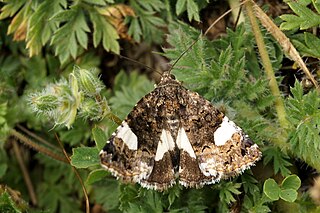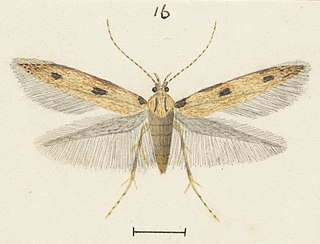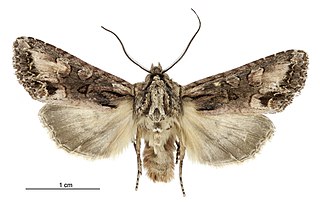
Agrotis segetum, sometimes known as the turnip moth, is a moth of the family Noctuidae. The species was first described by Michael Denis and Ignaz Schiffermüller in 1775. It is a common European species and it is found in Africa and across Eurasia except for the northernmost parts.

Tyta luctuosa is a noctuid ("owlet") moth. Its common names include four-spotted moth and field bindweed moth. It is the only member of the genus Tyta, which belongs to the Metoponiinae subfamily. The species was first described by Michael Denis and Ignaz Schiffermüller in 1775. The genus was erected by Gustaf Johan Billberg in 1820.

Caradrina clavipalpis, the pale mottled willow, is a moth of the family Noctuidae. The species was first described by Giovanni Antonio Scopoli in his 1763 Entomologia Carniolica. It is found in the Palearctic realm. It is an introduced species in North America, where it was first reported from Queens in New York City in 1993. In 2009 it was found in Rochester, New York, so it appears to be established and spreading.

Udea prunalis is a moth of the family Crambidae. It is found in Europe and China. The species was first described by Michael Denis and Ignaz Schiffermüller in 1775. In the Butterfly Conservation's Microlepidoptera Report 2011 this species was classified as common in the UK.
Dolichobela is a monotypic moth genus of the family Crambidae described by Alfred Jefferis Turner in 1932. It contains only one species, Dolichobela celidograpta, described in the same publication, which is found in Australia, where it has been recorded from Queensland.

Synthymia is a genus of moths of the family Noctuidae. It contains only one species, Synthymia fixa, The Goldwing, which is found in southern Europe and North Africa.

Bucculatrix frangutella is a moth of the family Bucculatricidae. It was described by Johann August Ephraim Goeze in 1783. It is found in Europe.
Trichoptilus scythrodes is a moth of the family Pterophoridae that can be found in Australia, including New South Wales and South Australia.
Batrachedra plagiocentra is a species of moth of the family Batrachedridae. It is found in Australia.
Batrachedra sterilis is a species of moth of the family Batrachedridae. It is found in Australia.
Batrachedra trimeris is a species of moth of the family Batrachedridae. It is found in Australia.

Tiracola plagiata, the cacao armyworm, is a moth of the family Noctuidae. The species was first described by Francis Walker in 1857. It is found from south-east Asia, South India, Sri Lanka, Myanmar to the South Pacific Islands, including the northern two-thirds of Australia.

Heterocrossa cryodana is a species of moth in the family Carposinidae. It is endemic to New Zealand.
Heterocrossa gonosemana is a species of moth in the family Carposinidae. It is endemic to New Zealand.

Labdia anarithma is a moth of the family Cosmopterigidae. It was described by Edward Meyrick in 1888. It is found in New Zealand and throughout Australia. Adults are on the wing from December to March and are day flying. They have been collected by sweeping bracken fern.
Zaphanaula hemileuca is a moth in the family Xyloryctidae, and the only species in the genus Zaphanaula. It was described by Turner in 1896. It is found in Australia, where it has been recorded from Queensland.
Lichenaula fumata is a moth in the family Xyloryctidae. It was described by Turner in 1898. It is found in Australia, where it has been recorded from Queensland.

Ichneutica bromias is a moth of the family Noctuidae. This species is endemic to the Chatham Islands of New Zealand where is found on the Chatham, Pitt and Rangatira Islands. This species is similar in appearance to Ichneutica mutans but is darker and duller in its overall appearance. However, as I. mutans is not present in the Chathams this similarity is unlikely to cause confusion. The adults of the species are on the wing from November to March. The life history and the larval host species are unknown.

Tingena hemimochla is a species of moth in the family Oecophoridae. It is endemic to New Zealand and has been observed in the North Island. Adults of this species are on the wing from December until March.

Trachypepla galaxias is a moth of the family Oecophoridae first described by Edward Meyrick in 1883. It is endemic to New Zealand and can be found throughout the country. This species inhabits native forest. The life history of this species is currently unknown. Adults are on the wing from October to February, are nocturnal and are attracted to light.











